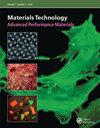Effect of the Juglans Regia (Walnut) leaf extract concentration on the biosynthesis of ZnO nanoparticles: Characterisation and antimicrobial activity
IF 3.7
4区 材料科学
Q3 MATERIALS SCIENCE, MULTIDISCIPLINARY
引用次数: 0
Abstract
ABSTRACT In the present article, we have developed an eco-friendly, phytosynthetic, cost-effective, and straightforward method for the synthesis of ZnO nanoparticles using leaf extracts of Juglans Regia (JR) as green reducing agents. The powder X-ray diffraction pattern revealed the high crystalline nature of synthesised ZnO nanoparticles also rivalled with ICSD no. 98–009-4004. The SEM images of the samples showed the spherical and irregularly distributed rod and plate-like structures. The EDS spectrum filed only Zn and O peaks revealed that the sample has good purity in ZnO nanoparticles. The HRTEM analysis explained the formed ZnO nanoparticles by biogenic reduction were hexagonal shape with definite edges and the average grain size was obtained as 33.18 ± 6.2 nm for the 50JR sample. The d-spacings of fringes and SAED pattern got also rivalled with XRD d-spacings. According to the UV-Visible analysis, the values of peak absorbance wavelength decreased (blue shift) with the increase in the leaf extract concentrations. The bandgap values were calculated in the range of 2.74–3.17 eV. The Fourier Transform Infra-Red study explicated the biomolecules for the reduction of nanoparticles and also ZnO bonding. These results also proved the presence of ZnO nanoparticles synthesised using Juglans Regia extract. Regarding the antimicrobial effects of ZnO NPs, ZnO NP which was using 50 mL JR extracts was detected as highly efficient nanoparticles against test microorganisms. In particular, the highest antimicrobial activity was measured with 15.66 ± 1.15 mm against Candida albicans 10,231 and revealed data compared with fluconazole, as reference antifungal, recorded 69% antimicrobial index. The findings demonstrated that ZnO NPs can be evaluated for use in biomedical applications. Graphical Abstract核桃叶提取物浓度对ZnO纳米颗粒生物合成的影响:表征及抑菌活性
摘要:本研究以核桃叶提取物(JR)为绿色还原剂,开发了一种环保、经济、直接的氧化锌纳米颗粒合成方法。粉末x射线衍射图显示合成的ZnO纳米颗粒的高结晶性也与ICSD no相媲美。98-009-4004。样品的SEM图像显示出球形和不规则分布的棒状和片状结构。EDS谱中只有Zn和O峰,表明样品中ZnO纳米颗粒纯度较高。HRTEM分析表明,50JR样品的生物还原法制备的ZnO纳米颗粒为六边形,边缘明确,平均晶粒尺寸为33.18±6.2 nm。条纹和SAED图的d-间距也与XRD的d-间距相当。紫外可见光谱分析表明,随着叶提取物浓度的增加,吸光度峰值波长降低(蓝移)。在2.74 ~ 3.17 eV范围内计算了带隙值。傅里叶变换红外研究阐明了生物分子对纳米颗粒和ZnO键的还原作用。这些结果也证明了用核桃提取物合成ZnO纳米粒子的存在。在氧化锌纳米粒子的抑菌效果方面,用50 mL JR提取物制备的氧化锌纳米粒子对被试微生物的抑菌效果较好。其中,对白色念珠菌10,231的抑菌活性最高,为15.66±1.15 mm,与氟康唑相比,抗菌指数为69%。研究结果表明,ZnO纳米粒子可以用于生物医学应用。图形抽象
本文章由计算机程序翻译,如有差异,请以英文原文为准。
求助全文
约1分钟内获得全文
求助全文
来源期刊

Materials Technology
工程技术-材料科学:综合
CiteScore
6.00
自引率
9.70%
发文量
105
审稿时长
8.7 months
期刊介绍:
Materials Technology: Advanced Performance Materials provides an international medium for the communication of progress in the field of functional materials (advanced materials in which composition, structure and surface are functionalised to confer specific, applications-oriented properties). The focus is on materials for biomedical, electronic, photonic and energy applications. Contributions should address the physical, chemical, or engineering sciences that underpin the design and application of these materials. The scientific and engineering aspects may include processing and structural characterisation from the micro- to nanoscale to achieve specific functionality.
 求助内容:
求助内容: 应助结果提醒方式:
应助结果提醒方式:


